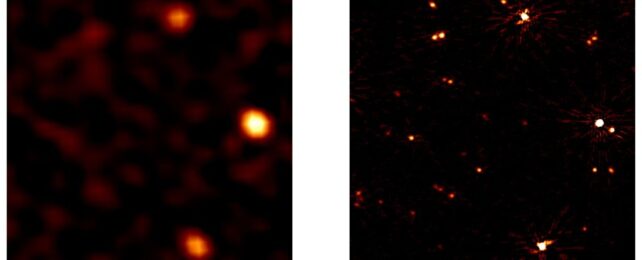The very lowest frequencies of the radio Universe have just been revealed in spectacular clarity.
A team of astronomers has used a new calibration technique to give us the first sharp images of the radio Universe in the frequency range of 16-30 megahertz – an achievement previously thought impossible, due to the turbulent interference generated by Earth's ionosphere.
"It's like putting on a pair of glasses for the first time and no longer seeing blurred," says astronomer Christian Groeneveld of Leiden University in the Netherlands, who led the research.
Seeing the Universe with radio eyes presents some interesting challenges at the best of times.
At the lowest end of the electromagnetic spectrum, the radio range consists of the longest waves, which means they can penetrate Earth's atmosphere. However, because the signals are often quite faint and because the wavelengths are quite long, the antennas with which we detect them need to be quite large.
So, putting a radio telescope in space simply isn't a cost-effective means of studying the radio sky, and most radio telescopes have been deployed and run right here on Earth. But for the decameter frequency range, below 30 megahertz, this means we've not been able to see what's out there in fine detail.
That's because of the ionosphere, which scatters low-frequency radio waves in so effectively that they arrive highly corrupted. The variable electron count in the ionosphere causes variable phase delays in the low-frequency wavefront; and interactions between electrons and magnetic fields in the ionosphere can cause the radio waves to rotate. The result is very blurry, out-of-focus images.
It's been a problem for as long as we've had radio astronomy. But back in 2004, astronomers predicted that we might be able to achieve much better resolution with projects such as LOFAR, a radio telescope array which was at the time still yet to be constructed.
LOFAR is now the largest radio telescope in the world, seeing the Universe in the lowest frequencies we can see from Earth. But the ionosphere is still the same old problem, so Groeneveld and his colleagues sought a way to correct for its interference.

Their calibration strategy works similarly to adaptive optics, which uses a guide star to help optical telescopes correct for the effects of atmospheric distortion. The researchers used the radio sources themselves as calibration targets, with sensitivity and resolution an order of magnitude higher than previous decameter observations.
The technique isn't perfect – lines radiate around radio sources in the new image; this is because the ionosphere causes the source to appear to move around. The calibration has pinpointed the source with higher precision, but some artifacts of the ionospheric influence remain. That's something that can be refined in further work.
For now, though, the team's efforts show a degree of precision that reveals details we'd never seen before. High-frequency and low-frequency radio emission is created by different processes and objects; studying galaxy clusters we'd only ever seen before in high-frequency radio waves showed that the emission is not evenly distributed, but has a sort of spotty pattern.
Outbursts from very distant black holes also produce low-frequency radio waves, so the new technique means astronomers have a much better tool for understanding black hole accretion in the early Universe.
For now, though, we know the technique works. The researchers are hard at work processing more data, hoping to eventually map the entire decameter northern sky. And, Groeneveld notes, "There is, of course, a chance that we will eventually discover something unexpected."
Yes, please.
The research has been published in Nature Astronomy.
